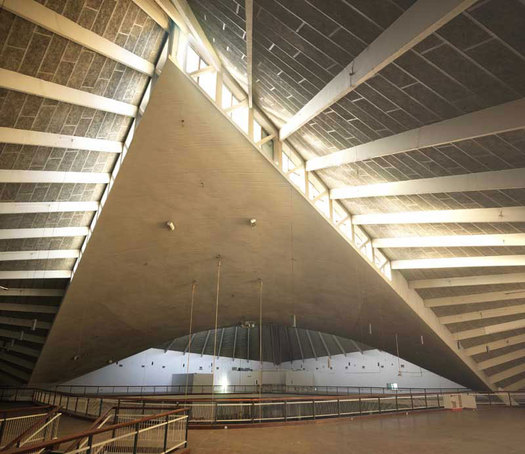
Interior, Commonwealth Institute, London. All photographs by James Biber.
This past fall, coincident with the London Design Festival, Open-City hosted the 19th annual Open House London, throwing open the doors to more than 750 significant architectural treats throughout the city. Among the most visited was the Commonwealth Institute, a quirky 1962 white elephant on Kensington High Street. Once filled with extensive exhibitions on Britainʼs vanishing empire, it sat empty for the last decade awaiting a new suitor.
These days, the only reason we think about the building in London is as the Design Museumʼs choice for its new home. But it also recalls the last vestiges of empire that the British maintained well into this century. It is, in my view, an alarmlingly bad building (and that is something I rarely utter), even on its own terms and especially for such an adventurous one. John Pawson has his work cut out for him.
In Berlin there was a similar monument to Empire, the Palast der Republik that sat near Schinkelʼs Altes Museum in the former East Berlin. It has, unfortunately, been demolished, a fate that the Commonwealth building sadly will not share. The buildings share more than an architectural vintage; they both had, or will have, lives as art museums, and they each celebrated, in their prime, an empire that is both gone and almost impossible to remember.
The very idea of celebrating the British Empire in the post-war era seems preposterous. Even Brits would admit to having their hands full with their own island kingdom. And the current facts of Canada and Australia and New Zealand are for them no more remarkable than Hawaii and Alaska and, well, Canada seem to the US. The true global imperial power (though the power part seems less true every day) is the country that has half a million troops planted in other countries, and leads the world in arms sales. Britain doesnʼt have those resources to toss around and no longer needs to occupy lands to absorb her natural or human resources. The free-ish market takes care of that. But the salvation of their monument to Empire is as telling as it is inappropriate.
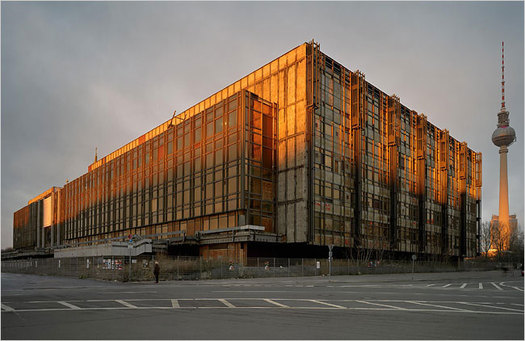
Exterior, Palast der Republik, Berlin
The GDR Communist Party in the 1960ʻs was, in a funny way, not unlike the tiny island of Britain. Its perceived power far outstripped its actual influence and if “The Lives of Others” is to be believed, spent far more time enslaving its own population than others. Physically its Palast der Republik (PdR) building had little in common with the Commonwealth Institute (CI) except for a very unusual choice of glass skin color; PdRʼs was gold mirror glass while the CIʼs was turquoise opaque panels. Both were taste makers of a perverse sort, the CI carrying the 1950ʼs forward and the PdR predicting Donald Trump a few decades in advance.
The PdR building was Germanic in every way. Strict, rectangular, heavy, huge, and sited ponderously at the eastern end of the Unter den Linden axis. It sat across from the Berliner Dom completing a kind of “God and Man” duet, with an “Art and War” axis connecting the nearby museums to the Brandenburg Gate 1,600 meters away at the western end of the Unter den Linden. A prime example of “GDR-Modern,” it delighted East Berliners as much as it offended westerners. Even the act of restoring the Berliner Dom (by, let us not forget, the G-dless communists) just as the PdR was opening didnʼt endear it to those who couldnʼt see past its clunky exterior and lavish (in a socialist way) interiors. But it represented the nearly attainable future just as much as the CI represented the nearly lost past.

Interior, Palast der Republik, Berlin
The PdR may have looked best when the interior was stripped to its (rusted) steel frame, which was how I saw it. The semi-demolished building housed a series of art installations and performances while it became the largest artifact of all. It was a bit of Gordon Matta-Clark and a bit of unwitting Mies in an admittedly absurd mashup of East Berlinʼs take on West Berlin. Art looked great in the PdRʼs industrialized interior with its enormous spaces and uniformly honest materials. Whether filled with water for an artificial lake, or housing an enormous glowing plastic iceberg, the PdR was as hospitable to art as Dia:Beacon is currently. And its organic adoption as Berlinʼs largest fun palace by the post unification youth is instructive; it doesnʼt take deep pocketed endowments and institutional directives to embrace a new art space. Just art, passion and visitors, all of which the PdR had.
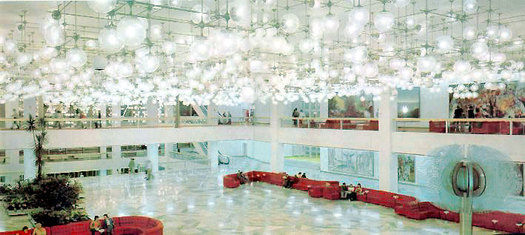
Interior, Palast der Republik, Berlin
Finished in 1976 (which might actually translate to 1962 in western trneds) the PdR was a true hybrid building: governmental center, massive entertainment venues, galleries and social incubator with restaurants and even a bowling alley all to provide the premier locale for East Berliners in the less than two decades between its opening and its obsolescence upon unification. Designed by Heinz Graffunder and Karl Ernst Swora on the site of the Berliner Schloss (home to Kaisers, emperors and kings) it was a true peopleʼs palace where the future of socialism could suddenly seem bright and shiny. Lovingly depicted in the short documentary “Brokedown Palast” by Ole Tangen, Jr., the PdR spontaneously became for young unified Berliners what it had been for East Berliners decades earlier, a home to art, performance and a new center of the city. In spite of, or because of, its dubious past the building was adopted, adapted and constantly transformed by events that capitalized on its raw interior, huge spaces and malleable image. It became organically what the CI can only hope to become with the greatest of "developer contrivance." Though strict and gridded, covered with a staid pattern of glass wall and externally unemotional, the PdR was a neutral container onto which anything could be projected.
The opposite is true of the CI building; utterly exuberant in every way, it can not decide what geometry it relies on, what materials make sense and what kind of space works best for its original content. Known by its grid of flagpoles from Kensington High Street, oddly tented roof from afar, its massive parabolic arch inside and its odd glass and brick base from on the grounds, it is a big mess of a building.

Exterior, Commonwealth Institute, London
The Commonwealth Institute is a building of either too many or too few ideas. Seeing it stripped of its original displays, and therefore its purpose, may be unfair to it (and overly fair to the PdR) but it does reveal the errant core of its problems. The space is almost entirely open, being a series of floors each with a central roundish opening where sets of unremarkable stairs connect the stories. The overarching concrete shell-arch supports (I guess) the odd roof and a wan skylight invisible to the visitor except obliquely. Its Darth Vader moments are, in isolation, quite elegant but meet the rest of the building in a truly awkward set of contortions that will simply not go away.
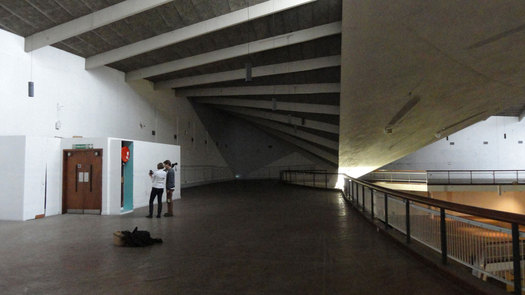
Interior, Commonwealth Institute, London
I swear to all that is "the masterly, correct, and magnificent play of masses brought together in light" that I rarely take the time to trash a bit of historical urbanism this way. I loved the semi-beautiful Huntington Hartford and embrace even the most banal Emery Roth buildings. Well, maybe especially the most banal Emery Roth buildings. But this is different; a signature 1962 building created at one of the most delicate moments in modern architecture is now being revived for a Design Museum, and so it ceases to be just another building one can ignore. 1962 was a year of ambiguity. The Seattle Space Needle was a 1962 baby, as was Eero Saarinen's TWA Terminal, the New England Aquarium, as well as Walter Netsch's Air Force Academy Chapel. A mixed bag, to say the least. In 1962 the AIA Gold Medal went to Saarinen, the Architecture Firm Award to SOM. In England the RIBA Presidentʼs Gold Medal went to Sven Gottfried Markelius, and though I am sure he designed some very nice buildings, I don’t know a single one of them. Point made, I hope.
Nicolai Ouroussoff has compared the PdR to Cedric Priceʼs 1961 unbuilt Fun Palace, proving that London had the intellectual capital to build the future, but the political capital only to celebrate the past. Berlin once had that same intellectual and political capital, but it is now considering replacing the PdR with a replica of the Berliner Schloss destroyed as an artifact of empire in the 1950’s. This is as much an east-west (socialist-capitalist) issue as it is one about the nerve to imagine the future while coping with the past.
The PdR is gone but had real potential while it still stood. In the same way that one could, I suppose, wax poetic about the CI building’s quaint recall of a lost era, the PdR building could have memorialized an era while embracing a new purpose. But perhaps for the same reason that the Berlin Wall is nearly entirely eradicated, the PdR had to go. Too bad, as it embodied a bit of cultural genius and memories formed in both divided and unified Berlin. 300,000 people visited the stripped PdR for art and happenings, without much official sanction or assistance.
Like the CI building stripped of its exhibits, the PdR was emptied as well, but due in this case to asbestos removal. The original building interior looked like a rectangular world’s fair fully fleshed out with pomp, content, exuberance and a bureaucracy. There was an entry hall of 1000 lights, a giant glass flower sculpture and miles of white marble.
Buildings can be judged absent their content as we like to do with all ancient ruins, most medieval buildings and certainly the relics of pre-Civil War south. As an atheist I love a good church, a pacifist can love a good Armory, and Terragni’s Casa del Fascio is still on every liberal's list of great modern buildings. Form and space persevere and cover a multitude of sins, so it is fair to judge the artifacts we are left with, not just their original states.
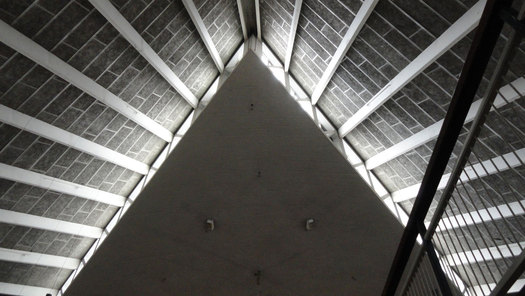
Interior, Commonwealth Institute, London
It remains to be seen if the Commonwealth Institute can be transformed into a working view of the future as seen from the past. That is, in the end, all that a design museum can be.
